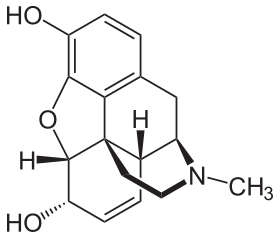Opioid antagonists
| Opioid | |
|---|---|
| Drug class | |

Chemical structure of morphine, the prototypical opioid.
|
|
| Class identifiers | |
| Use | Pain relief |
| ATC code | N02A |
| Mode of action | Opioid receptor |
| External links | |
| MeSH | D000701 |
Opioids are substances that act on opioid receptors to produce morphine-like effects. Medically they are primarily used for pain relief, including anesthesia. Other medical uses include suppression of diarrhea, treating addiction, reversing opioid overdose, suppressing cough, and suppressing opioid induced constipation.Extremely strong opioids are approved only for veterinary use such as immobilizing large mammals. They are also frequently used for their euphoric effects or to prevent withdrawal.
The side effects of opioids may include itchiness, sedation, nausea, respiratory depression, constipation, and euphoria. Tolerance and dependence will develop with continuous use, requiring increasing doses and leading to a withdrawal syndrome upon abrupt discontinuation. The euphoria attracts recreational use, and frequent, escalating recreational use of opioids typically results in addiction. An overdose or concurrent use with other depressant drugs commonly results in death from respiratory depression.
Opioids act by binding to opioid receptors, which are found principally in the central and peripheral nervous system and the gastrointestinal tract. These receptors mediate both the psychoactive and the somatic effects of opioids. Opioid drugs include partial agonists, like the anti-diarrhea drug loperamide and antagonists like naloxegol for opioid-induced constipation, which do not cross the blood-brain barrier, but can displace other opioids from binding in those receptors.
...
Wikipedia
